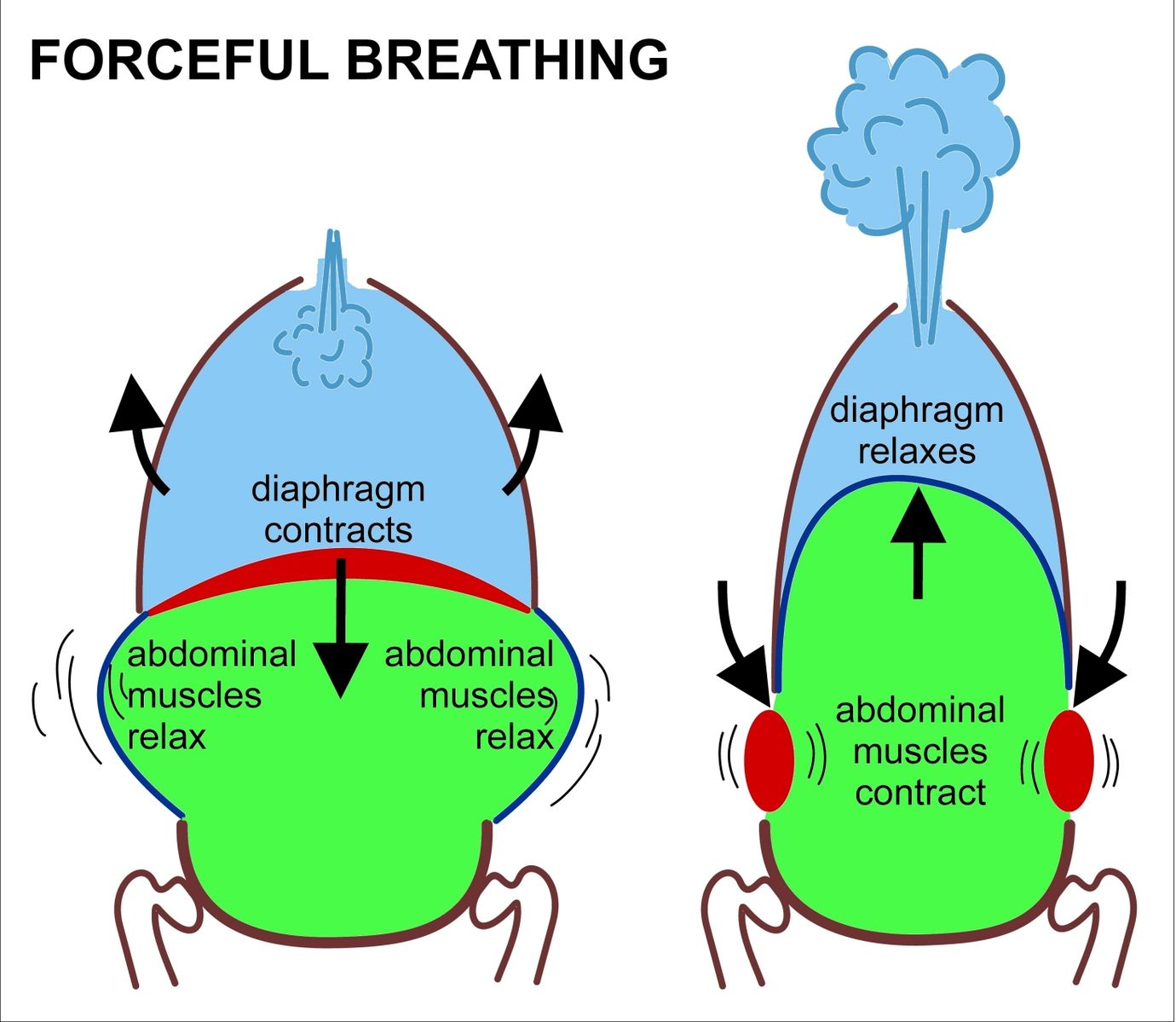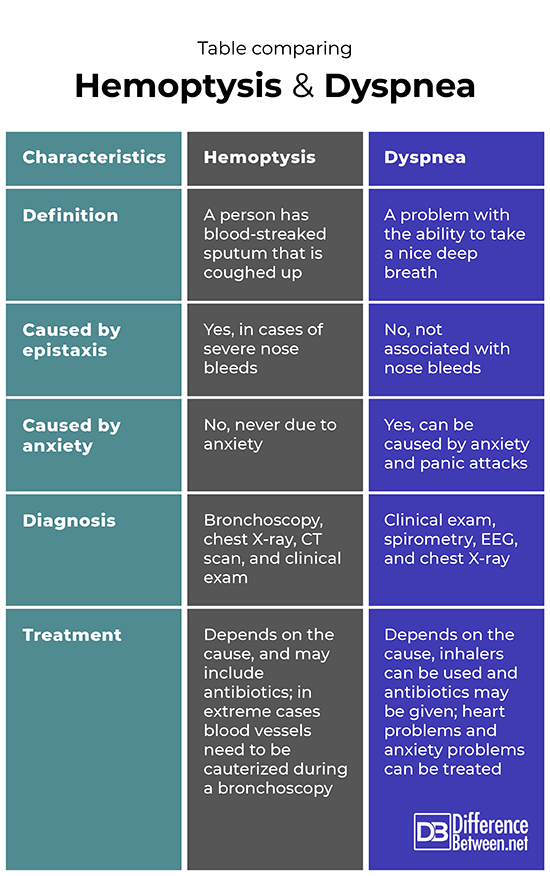Difference Between Hemoptysis and Dyspnea
Hemoptysis is when blood is expelled when a person coughs. Dyspnea is when there is difficulty in breathing and the person feels that they can’t take a good breath.

What is Hemoptysis?
Definition:
Hemoptysis is when a person coughs and blood is expelled in the sputum, and it often means there is some problem such as a bad chest infection or heart condition.
Symptoms:
The person discovers there is blood in their sputum after they cough. Depending on the cause of the problem there may be other symptoms such as a fever and chest congestion, especially if a person has a respiratory infection.
Diagnosis:
A physical exam and examining the sputum that is coughed up can help diagnose hemoptysis. It is often very important to diagnose the cause of the condition in order for appropriate and correct treatment measures to be instituted. CT scans, chest X-rays or bronchoscopy can also help with the diagnosis of the cause of coughing up blood.
Causes and complications:
Hemoptysis can be due to extreme coughing or even a bad nosebleed. Often severe chest infections such as those that occur with tuberculosis (TB), cystic fibrosis, and pneumonia can result in a person coughing up blood. More dangerous conditions, for instance, pulmonary embolism (PE) can also manifest as hemoptysis. Bleeding when there are chest infections is not normally too serious, but in rare cases hemoptysis can be dangerous where too much blood is lost. For instance, where serious TB invasion has occurred into the lung tissue and where a PE results in large blood vessel rupture.
Treatment:
When coughing up blood-streaked sputum is due to an infection, it often resolves on its own once the underlying condition is treated. This may mean taking antibiotics for the respiratory problem. If hemorrhage is extreme, then cauterizing the blood vessel becomes necessary and can be done during a bronchoscopy.

What is Dyspnea?
Definition:
Dyspnea is when a person finds it difficult to breathe such that they feel as though they are short of breath and cannot get enough air into their chest.
Symptoms:
A person has trouble catching their breath or feels that they are short of breath. Additional symptoms may include a feeling that the chest is tight, and that they can’t take a very deep breath. The uncomfortable sensation of dyspnea can result in considerable anxiety for the patient.
Diagnosis:
The dyspnea can be assessed by a clinical exam and also by spirometry, which tests lung function. A physical examination of the patient is done. The doctor will ask about past or current medical illnesses that could be responsible for the shortness of breath. Diagnosing why the person is short of breath is crucial for treatment of the problem. An EEG, chest X-rays and blood tests may also help to determine the cause of the dyspnea.
Causes and complications:
There are many reasons why a person may suffer from dyspnea, including problems with the respiratory system such as emphysema, bronchitis, chronic obstructive pulmonary disease, pneumonia, or asthma. Heart failure can also lead to shortness of breath. Coughing up blood (hemoptysis) can also result in a person experiencing dyspnea in some cases, especially where the person has a badly infected lung or a PE. Even cases of extreme anxiety and panic attacks can make a person feel short of breath. Other causes of dyspnea include anemia, collapsed lung, and excessive blood loss. Dyspnea can lead to complications if oxygen levels drop too low, resulting in organ damage.
Treatment:
Treatment options often depend on what the cause of the breathing difficulty is. An inhaler can help with respiratory problems such as asthma or pneumonia. Blood clots and heart conditions need to be treated medically, which can help with the dyspnea.
Difference between Hemoptysis and Dyspnea?
Definition
Hemoptysis is when a person is bleeding and their coughed-up sputum contains blood. Dyspnea is difficulty in breathing where the person cannot take a good deep breath and feels like they are short of breath.
Caused by epistaxis
Hemoptysis can sometimes be because of a nose bleed, especially if it is a bad bleed at the back of the nose. Dyspnea is never a result of a nose bleed.
Caused by anxiety
Anxiety does not cause a person to cough up blood. Anxiety can in some cases cause difficulty in breathing, or make a person feel short of breath.
Diagnosis
The diagnosis of hemoptysis is by bronchoscopy, chest X-ray, CT scan, and clinical exam. The diagnosis of dyspnea is by physical exam, spirometry, chest X-ray, and EEG.
Treatment
The treatment of hemoptysis depends on the cause and may include antibiotics; in extreme cases blood vessels need to be cauterized during a bronchoscopy. The treatment of dyspnea also depends on what is causing the condition, and it might include antibiotic therapy or use of an inhaler; treating heart or lung problems causing the condition can help.
Table comparing Hemoptysis and Dyspnea

Summary of Hemoptysis Vs. Dyspnea
- Hemoptysis and dyspnea are related in that coughing up blood can lead to shortness of breath.
- Both conditions can indicate a chest infection or the presence of a pulmonary embolism.
- Diagnosing the reasons for having dyspnea or hemoptysis is important in enabling the correct treatment to be given.
- Difference Between Rumination and Regurgitation - June 13, 2024
- Difference Between Pyelectasis and Hydronephrosis - June 4, 2024
- Difference Between Cellulitis and Erysipelas - June 1, 2024
Search DifferenceBetween.net :
Leave a Response
References :
[0]Dezube, Rebecca. “Dyspnea”. Merckmanuals. Merck & Co., 2020, https://www.msdmanuals.com/professional/pulmonary-disorders/symptoms-of-pulmonary-disorders/dyspnea
[1]Ittrich, Harald, et al. "The diagnosis and treatment of hemoptysis." Deutsches Ärzteblatt International 114.21 (2017): 371.
[2]Janson-Bjerklie, Susan, Virginia K. Carrieri, and Mark Hudes. "The sensations of pulmonary dyspnea." Nursing research (1986).
[3]Image credit: https://commons.wikimedia.org/wiki/File:Forceful_breathing.jpg
[4]Image credit: https://commons.wikimedia.org/wiki/File:Blood.jpg
